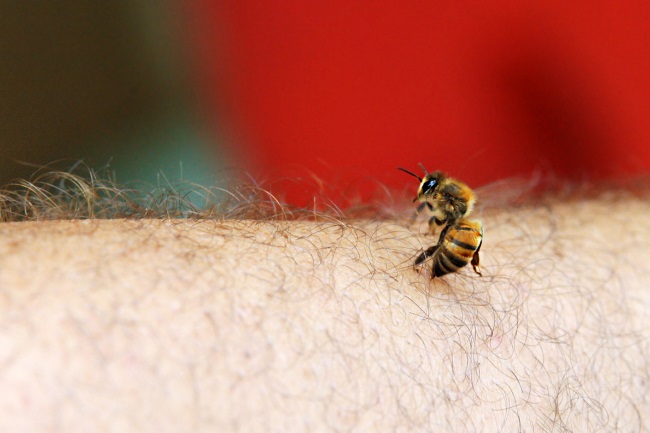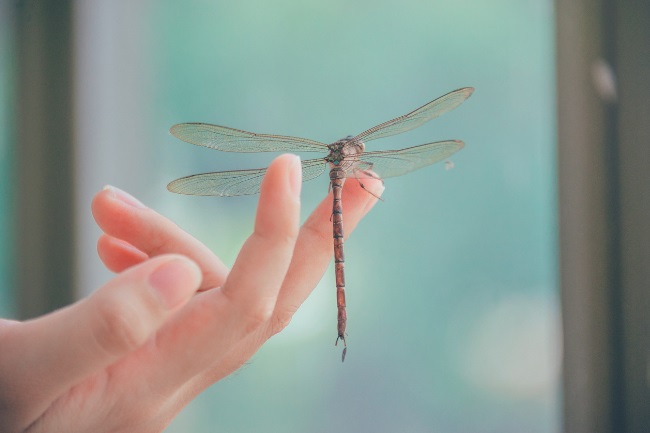Dragonflies do not possess stingers, unlike bees and wasp species. This means they are not able to sting. They catch their prey largely through speed and agility, rather than through the use of venom and stingers.
Contents
What is a stinger?

There are lots of different types of stingers in the animal kingdom, however, their main design purpose is to inject venom into another living animal. Venom is usually composed of a cocktail of different chemicals, designed to either kill, stun or simply cause pain to the animal that has been stung. Depending on what the venom causes in the other animal, it may assist the stinger in defending itself from an attacker or in hunting down a prey species.
Many people confuse stings with bites, particularly those of venomous creatures. For example, snakes administer their venom with their fangs, hollow teeth that can deliver their venom using attached venom sacks. While this mechanism is very similar to that used by species with stingers, it is defined as a bite rather than a sting, because it uses the animal’s mouth and teeth rather than a separate stinger. Other animals may bite without having any venom within their mouths. In this case, the action is still considered a bite.
Stingers are most famous within the bee and wasp family, however many other species also have stingers, such as scorpions, platypus and stingrays. The majority of stingers are hardened pointed appendages, hollowed out to allow the venom to be injected, like delivering medicine with a needle.
The Schmidt sting pain index is a scale by which the various stings of different Hymenoptera species have been categorised. While the honey bee is considered a 2 on the scale, the worst possible sting of all wasps, bees and ants is considered the bullet ant, a species found in the rainforests of central and South America.
Within the bee and wasp family, stingers have evolved from ovipositors that many female insects have in order to lay their eggs into a substrate, such as into the soil, or the leaf of a plant, or even into the skin of an insect.
Over time the stinger became used as a defence mechanism, able to deliver a short hard jab, and later evolving the ability to administer venom. The venom adds a significant punch to the sting, with some chemicals causing swelling, while others help to break down cells. This can either cause pain in larger creatures or potentially death in smaller ones.

Venom is administered through the use of venom sacks, which are attached to the base of the stinger. When the sting is being pushed into the skin, the venom is forced through the stinger into the flesh of the animal being stung. In many bee and wasp species, there are two venom sacks, which allows a more specific cocktail to be mixed depending on the situation.
With most species, the stinger is designed to be reused again and again, either as part of defence or for hunting purposes. Many wasps sting prey in order to paralyse them, so they can inject their young into their bodies, or simply devour them without risk of being harmed by the creatures they are eating. Scorpions may sting repeatedly so that they can kill their prey.
Famously, the stings of honey bees are known to kill the bee too. This is because unlike the stingers of wasps, the stingers are curved instead of straight. The stinger is composed of three parts, two barbed and one straight. These barbs help to pull the stinger deeper into the skin, however, they have the unfortunate side effect of causing the stinger to get stuck.
This means that when they sting a mammal the stinger gets caught and as the bee pulls away the abdomen tears, killing the bee. It is thought that the curved stinger is designed to get through the skin of insects, rather than mammals.
Also read: Can Butterflies Sting? How do They Protect Themselves?
Do dragonflies have stingers?

Dragonflies have a very different hunting style to bees and wasps. They are expert fliers and can grab other insects straight out of the air. What makes them such excellent fliers is that each of their four wings can move independently of each other. This means that they can perform complex manoeuvres in the air, and can turn swiftly.
Most of the species that dragonflies hunt are significantly smaller than them, such as mosquitos and flies. Once they have grabbed hold of these insects they will use their large powerful jaws to munch through their bodies, killing them relatively quickly.
It’s therefore because they are such amazing and efficient hunters that they don’t have a need for a stinger. Producing venom is an energy-consuming task, one which isn’t in the creature’s interest if they can successfully catch and consume prey without it.
| Characteristic | Dragonfly Stings | Wasp Stings |
|---|---|---|
| Source | Male dragonflies defending territory | Female wasps protecting their nests |
| Frequency | Rare occurrence | More common in the presence of nests |
| Venom | Dragonflies do not possess venom | Wasps inject venom through stingers |
| Pain Level | Mild discomfort | Intense pain, potentially dangerous |
| Allergic Reactions | Rare occurrence | Allergic reactions more common |
| Health Concerns | Minimal health concerns | Potential for severe allergic reactions |
What often confuses many observers of the dragonfly is the fact that the females have an ovipositor and males have anal claspers used to grasp females during sex. These appendages can easily be confused for a stinger, however, they do not have the ability to sting.
Another confusion can arise from how the dragonflies mate and lay their eggs. When mating the male will grasp the female behind the head using his anal claspers. They may remain joined in this position for quite a while. The female will then move her abdomen forward for the male to pass over his sperm. They will then be joined in what is known as the love knot.
When the female is laying her eggs some species use their ovipositor to cut holes into leaves or bark to safely deposit the egg within. She will often be sat with her ovipositor pointing downwards into the ground. Both this position and the various coupling positions can call to mind a creature using its sting to administer venom.
This idea can be encouraged by the fact that males and females often look different, meaning they can appear to be from different species. However, during this process, it is love, not war that the dragonflies are thinking of.
Do dragonflies sting humans?

As dragonflies do not have stingers they are not able to sting humans. However, they do have a jaw, and some large species may attempt to bite a human if they are being held. For most species, this bite will barely be felt, but in some, it may feel like a pinch.
Another common confusion can be that the dragonfly has a hard exoskeleton. If it moves suddenly while in a tight grasp this may cause a slight friction, which may feel uncomfortable. In general, though, most species are very calm and placid.
| Dragonfly Species | Stinging Behavior |
|---|---|
| Common Green Darner (Anax junius) | Males may exhibit territorial aggression, but no stinging behavior reported. |
| Eastern Pondhawk (Erythemis simplicicollis) | No stinging behavior reported. |
| Widow Skimmer (Libellula luctuosa) | No stinging behavior reported. |
| Blue Dasher (Pachydiplax longipennis) | No stinging behavior reported. |
| Twelve-Spotted Skimmer (Libellula pulchella) | No stinging behavior reported. |
Do dragonflies sting dogs?

Just like with humans, dogs cannot be stung by dragonflies, as the dragonflies do not have stingers. However, many pets, such as dogs and pets, may have a fascination or fear of wildlife, such as insects. This may mean that they attempt to chase or catch dragonflies, or maybe be scared when they come too close. The dragonfly will not, however, harm the pet.
Dragonflies: Friends or foes?
As more and more people spend their lives within cities, most of which are depleted in insect life, there is a tendency for people to become more cautious and fearful of insects. However, the majority of insects are highly beneficial to our world and provide services that we couldn’t do without.
The dragonfly is a classic example of this. Many people can be concerned about the potential for dragonflies to be harmful, due to their large size and the noise they make as they fly nearby. However, these insects are entirely harmless to humans, having no stingers and not being inclined to bite.
In terms of benefits, dragonflies eat a large number of flies, mosquitoes and other smaller insects. This means that they help to keep other potential pest species in check, benefiting both us and the crops we rely on.

